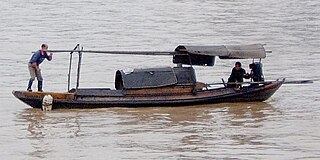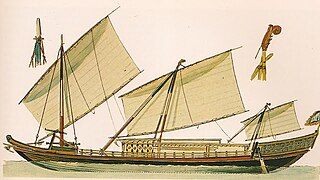
A junk is a type of Chinese sailing ship with fully battened sails. There are two types of junk in China: northern junk, which developed from Chinese river boats, and southern junk, which developed from Austronesian ships visiting southern Chinese coasts since the 3rd century CE. They continued to evolve in later dynasties and were predominantly used by Chinese traders throughout Southeast Asia. Similar junk sails were also adopted by other East Asian countries, most notably Japan, where junks were used as merchant ships to trade goods with China and Southeast Asia. They were found, and in lesser numbers are still found, throughout Southeast Asia and India, but primarily in China. Historically, a Chinese junk could be one of many types of small coastal or river ships, usually serving as a cargo ship, pleasure boat, or houseboat, but also ranging in size up to large ocean-going vessel. Found more broadly today is a growing number of modern recreational junk-rigged sailboats. There can be significant regional variations in the type of rig or the layout of the vessel; however, they all employ fully battened sails.

Terengganu, formerly spelled Trengganu or Tringganu, is a sultanate and federal state of Malaysia. The state is also known by its Arabic honorific, Dāru l-Īmān. The coastal city of Kuala Terengganu, which stands at the mouth of the broad Terengganu River, is both the state and royal capital as well as the largest city in Terengganu. Other major cities and towns includes Jerteh, Kuala Dungun, Chukai, Kuala Berang, Marang, and Permaisuri. At 13,035 square kilometres in size and a population of around 1.14 million people, Terengganu is Malaysia's 7th largest state by area and 10th largest in population. Terengganu, along with Kelantan, Perlis and the Federal Territory of Putrajaya is one of the most homogeneous states/territories in the country of which 95% of the population are ethnic Malay-Muslims with its own distinct language/dialect, culture, history and tradition.

A sampan is a relatively flat-bottomed Chinese and Malay wooden boat. Some sampans include a small shelter on board and may be used as a permanent habitation on inland waters. The design closely resembles Western hard chine boats like the scow or punt. Sampans are generally used for transportation in coastal areas or rivers and are often used as traditional fishing boats. It is unusual for a sampan to sail far from land, as they do not have the means to survive rough weather.

Kuala Terengganu, colloquially referred to as KT, is the administrative, economic and royal capital of the state of Terengganu, Malaysia. Kuala Terengganu is also the capital of Kuala Terengganu District. It is also the only royal capital among the nine royal states of the country to bear its state's name. Kuala Terengganu is located about 440 kilometres northeast of Kuala Lumpur on the East Coast of Peninsular Malaysia. The city is situated at the estuary of Terengganu River, facing the South China Sea.

Kemaman is a district in Terengganu, Malaysia. Kemaman District is bordered by Dungun District to the north and the state of Pahang to the south and west. It is the southern gateway to the state of Terengganu.

The junk rig, also known as the Chinese lugsail, Chinese balanced lug sail, or sampan rig, is a type of sail rig in which rigid members, called battens, span the full width of the sail and extend the sail forward of the mast.

The lorcha is a type of sailing vessel having a junk rig with a Cantonese or other Chinese-style batten sails on a Portuguese or other European-style hull. The hull structure made the lorcha faster and able to carry more cargo than the normal junk. The advantage of the junk rig was in its ease of handling and resulting reduced crewing requirement, together with its relatively low cost of construction. Owing to its simplicity, it was also easier to repair. Lorchas were made locally of camphor or teak and generally were of 30 to 150 tons burthen.
The Monsoon Cup was a yacht race in Malaysia, held in the state of Terengganu.

Literally, the word pinisi refers to a type of rigging of Indonesian sailing vessels. A pinisi carries seven to eight sails on two masts, arranged like a gaff-ketch with what is called 'standing gaffs' — i.e., unlike most Western ships using such a rig, the two main sails are not opened by raising the spars they are attached to, but the sails are 'pulled out' like curtains along the gaffs which are fixed at around the centre of the masts.

Paraw are various double outrigger sail boats in the Philippines. It is a general term and thus can refer to a range of ship types, from small fishing canoes to large merchant lashed-lug plank boats with two outriggers (katig) propelled by sails

Tongkang or "Tong'kang" refers to several type of boats used to carry goods along rivers and shoreline in Maritime Southeast Asia. One of the earliest record of tongkang has a background of 14th century, being mentioned in Malay Annals which was composed no earlier than 17th century. One passage mentioned it as being used by Majapahit empire during the 1350 attack on Singapura.

The pinas, sometimes called "pinis" as well, is a type of schooner of the east coast of the Malay peninsula, built in the Terengganu area. This kind of vessel was built of Chengal wood by the Malays since the 19th century and roamed the South China Sea and adjacent oceans as one of the two types of traditional sailing vessels the late Malay maritime culture has developed: The bedar and the pinas.

The term bedar,, is applied to a wide variety of boats of the east coast of Malaysia that carry one or two junk sails and lack the typical transom stern of the perahu pinas. These junk rigged boats are usually built in the Terengganu area. The stern of the bedar is a classical "canu" or "pinky stern," being a typical "double ender", a bit like a modern ship's lifeboat, with a very full turn of the bilge and with markedly raked stem and stern. They came in small versions as small one-masted fishing vessels — anak bedar and were built as big as 90 feet over deck (LOD). The majority of the bedars were usually 45 to 60 feet over deck. The bedar, like all Terengganu boats, was built of Chengal wood by the Malays since the 19th century and roamed the South China Sea and adjacent oceans as a highly seaworthy traditional sailing vessel.

Kuala Nerus is a district in Terengganu, Malaysia. It is the youngest district in the state, having been declared a separate district in 2014. Formerly it was part of Kuala Terengganu district but the district is still governed by Kuala Terengganu City Council (MBKT) which is one of few city councils in Malaysia to govern two separate districts. Its capital is Kuala Nerus town, other major towns and villages include Gong Badak, Seberang Takir, Batu Rakit and Batu Enam, all which are located within city limits of Kuala Terengganu. Kuala Nerus' population is 226,177 people as of 2015 which makes it the most populous district in Terengganu. The district has a total land area of 397.52 km2.

Tanja sail or tanja rig is a type of sail commonly used by the Austronesian people, particularly in Maritime Southeast Asia. It is also known as the tilted square sail, canted rectangular sail, rectangular balance lug, or balance lug sail in English. In historical sources, tanja sail is sometimes incorrectly referred to as lateen sail or simply square sail.

Palari is a type of Indonesian sailing vessel from South Sulawesi. It was mainly used by the people of Ara and Lemo Lemo, for transporting goods and people. This vessel is rigged with pinisi rig, which often makes it better known as "Pinisi" instead of its name. In Singapore, palari is known as "Makassartrader".

Perahu payang or simply payang is a traditional Malay open fishing boat. They are usually found in Terengganu, and to a lesser extent, Kelantan, Pahang, and Johor coasts. A few examples normally come down to Singapore to operate during the period of the north-east monsoon in the South China Sea.

Bangkong is the war boat of dayak people, notably used by sea dayaks of Indonesia, Malaysia and Brunei. They are used for riverine warfare in Borneo, but they are also capable of sailing across the sea.

Traditional Malaysian art is primarily composed of Malay art and Bornean art, is very similar with the other styles from Southeast Asia, such as Bruneian, Indonesian and Singaporean. Art has a long tradition in Malaysia, with Malay art that dating back to the Malay sultanates, has always been influenced by Chinese, Indian and Islamic arts, and also present, due to large population of Chinese and Indian in today's Malaysian demographics.





























